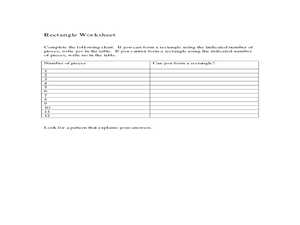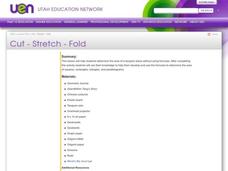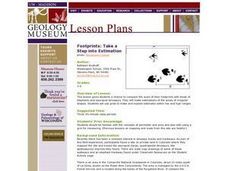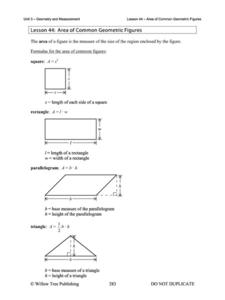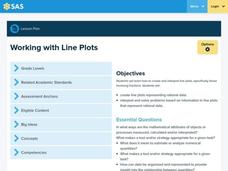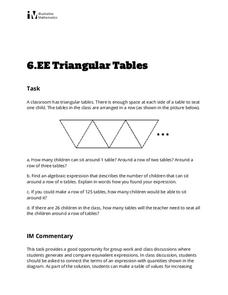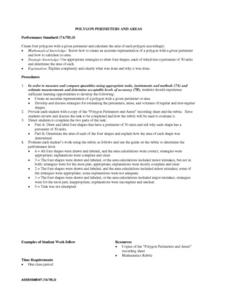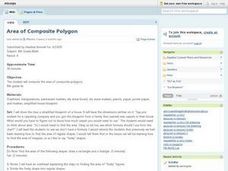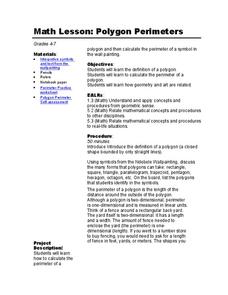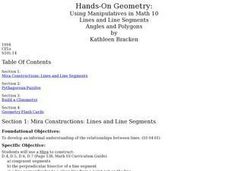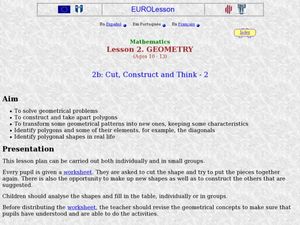Curated OER
Area, Perimeter and Rations Using Pentominoes
Learners of all ages investigate area and perimeter through pentominoes. In this geometry lesson, students calculate the are and perimeter of different geometric shapes and describe the properties of similar and congruent shapes. This...
Curated OER
Area of Tangram Pieces
Mathematicians calculate the area of a tangram piece without using formulas. They use a geometry journal to record activities during this instructional activity. They make a set of tangrams and use them to...
Curated OER
Poems: calligrams
Have fun with shape poems! First and second graders write calligrams that add to the meaning of their poems. Great for your poetry unit or if you want to combine poetry and art lessons.
Curated OER
Footprints: Take a Step into Estimation
Compare sizes of student footprints with those of elephants and sauropod dinosaurs! Upper graders make estimations of the areas of irregular shapes; students use grids to make and explain estimates within low and high ranges.
Curated OER
Birds' Eggs
More than just data, scatter plots are full of information that can be used to answer a variety of questions. This lesson uses a plot with information about bird egg sizes to answer questions about the relationship between length and...
Willow Tree
Angle Sum Property of Triangles
All triangles have some things in common. Using these properties of triangles, learners find missing angle measures. Scholars use the Angle Sum Property and properties of special triangles throughout the lesson.
Willow Tree
Area of Common Geometric Figures
Scholars can use area formulas, but can they apply what they know about area? The lesson challenges learners to think logically while practicing finding area of shapes such as rectangles, circles, parallelograms, triangles, and other...
Curated OER
Measuring Volume/Capacity Using the Metric System
There is more than one way to measure an amount, as learners discover by applying multiple measurement tools in these activities. Centimeter cubes, cylinders, beakers, and measuring cups are used to find the volume of regular and...
Illustrative Mathematics
Triangular Tables
Somewhat of a puzzle, this problem gets pre-algebra preteens to write an expression representing a seating chart using triangle-shaped tables. This single task is an applicable lesson for meeting sixth grade Common Core math standards....
Savvas Learning
City Building
First off, this worksheet is adorable! It has seven unit cube buildings drawn on it, complete with trees, paths, and fountains. Upper graders find the volume of each of seven buildings in cubic units. The drawings are attractive, and the...
Illustrative Mathematics
Tossing Cylinders
Everyone loves a lesson that involves throwing things around! To understand probability, your experimenters will predict how different cylinder-shaped objects will land when tossed. When the data is collected, they will calculate the...
Curated OER
Calculating Perimeter and Area of Polygons
Students discuss strategies for estimating information about various shapes. Once they draw and label four shapes with perimeters of 30 units, they calculate the areas of the figures. To complete the lesson, students offer written...
Curated OER
Regular Polygons
Fifth graders explore polygons. In this math instructional activity, 5th graders find examples of regular polygons in the classroom and measure the sides of figures to determine if they are regular polygons.
Curated OER
Area of Composite Polygon
Eighth graders are shown a blueprint of a house and must determine the amount of carpet needed. In groups, they calculate the area of rectangles and triangles and apply them to the shapes in the blueprint. To end the lesson, they...
Curated OER
Polygon Perimeters
Students complete worksheets where they calculate the perimeter of polygons. In this perimeter of polygons lesson plan, students divide complex shapes into simple shapes to find the perimeter.
Curated OER
Symmetry that is Basic and Beautiful
Students explore lines of symmetry. In this symmetry instructional activity, students divide and combine shapes along basic lines of symmetry. Students explore symmetry in real life objects.
Curated OER
Introducing Angles
Sixth graders identify, compare and interpret the characteristics of polygons and angles in order to meet spatial sense, geometry and measurement standards. They also sort shapes into three categories, polygons (regular and irregular)...
Curated OER
Classifying Polygons
Students study polygons. In this math instructional activity, students play a game in which they learn the classification system for polygons. Students identify the properties of quadrilaterals.
Curated OER
Mean and Standard Deviation
Get two activities with one lesson. The first lesson, is appropriate for grades 6-12 and takes about 20 minutes. It introduces the concept of measures of central tendency, primarily the mean, and discusses its uses as well as its...
Curated OER
Hands-On Geometry
Tenth graders construct a variety of geometric shapes and designs using a Mira, Clinometer and Geometry Flash Cards. They complete a worksheet.
Curated OER
Geometry: Cut, Construct and Think
Young scholars explore polygons. In this geometry skills lesson, students complete an activity that requires them to solve geometry problems that involve polygons as they piece together geometric shapes. Young scholars analyze the shapes...
Curated OER
Polygon Perimeters
Learners define the terms polygon and perimeter to begin the lesson. Using a calculator, they practice determining the perimeter of various symbols in a painting. They discuss how geometry and art are related to one another.
Curated OER
Reflections
Fifth graders create a reflection of a poygon using a Mira. They discover that a line connecting a vertiex of a polygon and the corresponding vertex of its reflection is perpendicular to the line of reflection. Students create a glide...
Curated OER
Problem Solving Using Power Polygons
Students investigate geometric shapes by creating figures on a plane. For this polygon lesson, students complete a worksheet based on the angles in a power polygon. Students identify the different types of polygons and define their...
